UNESCO World Heritage Sites in Italy: 51 masterpieces
Italy is the leader on the sites that are included in the UNESCO World Heritage List. The official list of UNESCO objects unites 51 masterpieces created on the territory of modern Italy by man or nature.
These attractions are talked about for their own good: in this way UNESCO signals to mankind that these masterpieces are not only beautiful, but also need attention and protection of society.
UNESCO sites in Italy today are presented in eight different categories and have different criteria for their uniqueness. The first six criteria relate to the objects from the sphere of culture.
- 1. Masterpieces of human creative genius.
- 2. Objects that have arisen as a result of the interaction of human values (in culture and art, in architecture, urban planning and landscape creation, and in technology).
- 3. Cultural or civilizational phenomena.
- 4. Historical constructions, architecture, technological ensembles or landscape.
- 5. Traditional structures that are examples of human interaction with nature and the environment (in particular, with extinct phenomena).
- 6. Objects of world culture associated with traditions, ideas or faith, with works of art or literature.
Two more criteria cover the natural phenomena of Italy – together with unique beautiful places (7) and the samples of main stages of the history of the existence of our planet (8). Most often the object of UNESCO represents several criteria of uniqueness at the same time. This makes every journey – even a mental one – to a new masterpiece even more exciting!
Venice and its lagoon (criteria 1-6)
UNESCO sites in Venice are interesting and diverse. The city itself is a luxurious kingdom of water, where gondoliers cut the water instead of the pages... You will fall in love with Venice from the first time – and, as a rule, for eternity. The Venetian lagoon unites about a hundred islands. Among them, for example, is San Lazzaro degli Armeni, the world-famous center of Armenian culture, and Lido di Venice – the medieval island of Saint Nicholas.
 Photo: © Iakov Kalinin - Fotolia.com.
Photo: © Iakov Kalinin - Fotolia.com.
Information for travellers
Historic centre of Rome and the Vatican City (1-4, 6)
The UNESCO sites in Rome and Vatican are primarily associated with the sacred heritage of Europe. The center of Rome and the Vatican's possessions, enjoy the rights of extraterritoriality (including the Church of San Paolo Fuori le Mura) were included in the World Heritage List as one complex.
 Photo: SashaLuk IGotoWorld PG.
Photo: SashaLuk IGotoWorld PG.
Information for travellers
- What to see in Rome and in the Vatican
- Where to stay in Rome
The historic centre of Florence (1-4, 6)
The value of UNESCO's objects in Florence (the "Cradle of the Renaissance") is not only in their history, but also in a unique architectural form. It is not surprising that during its existence the city managed to make the dukes of the Medici fall in love with it, to become the capital of the republic and the kingdom. To become a birth place of the world-famous Dante Alighieri, Galileo Galilei, Leonardo da Vinci, Michelangelo Buonarroti, Niccolo Machiavelli...
 Photo: SashaLuk IGotoWorld PG.
Photo: SashaLuk IGotoWorld PG.
Information for travellers
Basilica of St Francis and Franciscan monuments, Assisi (1-4, 6)
UNESCO sites in Assisi (Perugia province in Umbria) are associated with the history of St Francis, a monk and a righteous person of the 12th and 13th centuries, founder of the mendicant Order of the Lesser Brothers (Franciscans). In the city of Assisi there is a monastery complex of St Francis, and nearby – the first Franciscan church of Santa Maria degli Angeli. Also the church of St Clara, as well as the Romanesque Cathedral of San Rufino are worth a visit.
 Photo source: anticacanonica.it.
Photo source: anticacanonica.it.
Information for travellers
- What to see in Assisi? The city also preserves the pre-Christian heritage: it is the portico of the temple of Minerva
- Temples of Assisi
- Where to stay in Assisi
Villa d'Este, Tivoli (1-4, 6)
Villa d'Este (palace and garden) is a journey to Italy of the 16th century. At that time Cardinal Ippolito II d'Este wanted to create an amazing villa near Rome, woven with the dynamic power of fountains, gifts of nature and masterpieces of art. Villa d'Este is often mentioned in connection with Mannerism – a direction that is sometimes simply called the early Baroque. Also, the Villa Adriana belongs to the UNESCO sites in Tivoli (the Lazio region, the province of Rome), which we will recall later.
 Photo: Miguel Hermoso Cuesta.
Photo: Miguel Hermoso Cuesta.
Information for travellers
- What to see in Tivoli
- Temples of Tivoli. It is, first of all, the Cathedral (Duomo), the churches of Santa Maria Maggiore, San Silvestro and San Pietro alla Carita.
- Where to stay in Tivoli
Ferrara city and the delta of the Po river (2-6)
Ferrara is a city of culture and art of the Renaissance, the capital of the province with same name in the Emilia-Romagna region. The UNESCO objects in Ferrara are the Gothic rigor of castles, the splendor of the cathedrals, the aristocratic beauty of the palaces... And also the evidence of fruitful cooperation between man and nature: Ferrara is situated in a complex delta of the Po River.
 Photo source: agriturismostrozza.it.
Photo source: agriturismostrozza.it.
Information for travellers
Early Christian monuments, Ravenna (1-4)
In this city, there are eight unique sights of the Late Antiquity (5-6 century). This is how the UNESCO sites in Ravenna ware formed. These are the mausoleums (Galla Placidia and Theodoric), baptisteries (Orthodox and Arian), basilicas (San Vitale, Sant Apollinaire Nuovo and Sant Apollinaire in Class), as well as the Archdiocesan Museum and the Chapel of the Apostle Andrew.
 Frescoes of the Basilica of San Vitale. Photo source: quaterpassnextg.blogspot.com, author Mario Sala.
Frescoes of the Basilica of San Vitale. Photo source: quaterpassnextg.blogspot.com, author Mario Sala.
Information for travellers
Royal Palace, Aqueduct of Vanvitelli and San Leucio Village, Caserta (1-4)
Numerous UNESCO sites in Caserta are delightful in their diversity. Caserta, the center of the province of the same name, is in the region of Campania. Here, the imagination of travelers is amazed by the grandeur of the Palace of Neapolitan kings with a park (18th century) and a powerful construction of the aqueduct of Vanvitelli. And the factory village of San Leucio was created nearby – around the silk factory, which became the technical and social achievement of that time. Elite production is operating till now.
 Photo source: imparziale.com.
Photo source: imparziale.com.
Information for travellers
- What to see in the surroundings of Caserta
- Temples of Caserta. There are many of them in the district. For example, you can visit the Cathedral of St Archangel Michael on the Piazza Duomo and the Church of the Good Shepherd in Piazza Pitesti.
- Where to stay in Caserta
Cathedral, Torre Civica and Piazza Grande, Modena (1-4)
The UNESCO sites in Modena (Emilia-Romagna) are the three main attractions that make up one architectural ensemble. It is the Cathedral of the Assumption of the Blessed Virgin Mary and St Geminianus, the Torre Civica tower ("Ghirlandina") and the Piazza Grande square.
 Photo source: myarchstories.wordpress.com.
Photo source: myarchstories.wordpress.com.
Information for travellers
- What to see in Modena
- Temples of Modena. The history of the "Chiesa Della Madonna Del Voto" is interesting. It was built as a gratitude to the Virgin Mary from those who survived in Modena during the plague epidemic (17th century)
- Where to stay in Modena
Archaeological area, Agrigento (1-4)
The ancient Greek buildings of the Sicilian city of Agrigento are still beautiful in their greatness. The UNESCO sites in Agrigento are, first of all, the destroyed temple of Zeus the Olympic, the giant Atlant, the miraculously preserved Temple of Accord, the temples of Hera and Hercules. Some temples – Jupiter, Dioscuri, Aesculapius and Ephesus – survived only in ruins. Also on the Valley of the temples, as this place is called, are located early Christian cemeteries (necropolises).
 Photo source: outandaboutinparis.com.
Photo source: outandaboutinparis.com.
Information for travellers
- What to see in Agrigento
- Temples of Agrigento. It is the Baroque church of St Laurentia, Cathedral, etc
- Where to stay in Agrigento
Residences of the Royal House of Savoy, Turin and the surroundings (1-2, 4-5)
The 14 possessions of the Savoy royal dynasty are found both in the city of Turin and in the Piedmont region as a whole (north of Italy). The UNESCO sites in Turin are the Royal Palace, Palazzo Madama, Palazzo Carignano, Valentino Castle and Villa della Regina. UNESCO objects in Piedmont, related to the Savoy House, combine the hunting palace of Stupinigi, the royal palace of Venaria, the park of La Mandria and six ancient castles (Rivoli, Allier, Moncalieri, Racconidgia, Pollenzo, Govone).
 The Royal Palace in Turin. Photo source: lamiatorino.it.
The Royal Palace in Turin. Photo source: lamiatorino.it.
Information for travellers
Late Baroque Towns, Val di Noto (1-2, 4-5)
The cities of the late Baroque in the Val di Noto are in the provinces of Ragusa and Syracuse in the south-east of the island of Sicily. The UNESCO sites in Val di Noto are Ragusa, Noto, Caltagirone, Catania, Militello in Val di Catania, Modica, Palazzolo Acreide and Scicli.
 View of the city of Noto. Photo source: casavacanzelafonte.com.
View of the city of Noto. Photo source: casavacanzelafonte.com.
Information for travellers
- What to see in the province of Syracuse
- Temples of the province of Syracuse
- Where to stay in Syracuse
The Cathedral complex, Pisa (1-2, 4, 6)
Piazza dei Miracoli, that is, "the square of miracles" is the majestic dominant of the city of Pisa. In addition to the famous Leaning tower of Pisa (bell tower), UNESCO's objects in Pisa unite other wonders of the Middle Ages. It is the Cathedral of the Assumption of the Blessed Virgin Mary, the Baptistery of St. John the Baptist and the cemetery of Campo Santo (Holy Field).
 Photo source: 500px.com, author of Domingo Leiva.
Photo source: 500px.com, author of Domingo Leiva.
Information for travellers
The ancient city of Syracuse and the rocky necropolis of Pantalica (2-3, 4, 6)
UNESCO sites in the province of Syracuse are on the island of Sicily. Necropolis of Pantalica includes more than 5000 tombs, which are cut down in the rocks of the Hyblaean mountains long before our era. The ruins of the ancient Syracuse show that it was the largest city in the area of the Ancient Age ... Now the modern city of Syracuse is built here – the capital of the province of the same name.
 Photo source: ustodays.com.
Photo source: ustodays.com.
Information for travellers
- What to see in the province of Syracuse
- Temples of the province of Syracuse
- Where to stay in Syracuse
Castel del Monte, Andria (1-3)
Castel del Monte, one of the most famous medieval castles in the world, belongs to the UNESCO sites in Southern Italy. The castle is located in Terra di Bari, which is 16 km away from the city of Andria (province of Bari in Puglia).
 Photo source: gocasteldelmonte.it.
Photo source: gocasteldelmonte.it.
Information for travellers
- What to see in the province of Bari
- Temples of the province of Bari. The most famous is the Basilica of St. Nicholas in the city of Bari
- Where to stay in the province of Bari
Ancient Villa Romana del Casale, Sicily (1-3)
Villa del Casale is located near the city of Piazza Armerina in Enna and belongs to UNESCO sites in Sicily. It is decorated with unique mosaics, which are masterpieces of ancient Roman art (4th century).
 Photo source: pinterest.com.
Photo source: pinterest.com.
Information for travellers
Villa Adriana, Tivoli (1-3)
In Tivoli, in addition to Villa d'Este, one more piece of the ancient Roman art and architecture has been partially preserved. This is the villa of Emperor Hadrian (2nd century). Particularly interesting here are the Canopy Museum, the Pretoria, the Golden Square with mosaics and the Philosophers' Hall.
 Photo source: gardenofeaden.blogspot.co.uk.
Photo source: gardenofeaden.blogspot.co.uk.
Information for travellers
The historic centre of Siena (1-2, 4)
Medieval Siena was the centre of a prosperous and well-developed republic. You can make a small journey through time in the historical centre of the city, which has changed very little since then. UNESCO sites in Siena are well preserved: local people know how to protect their property.
 Photo source: palazzettorosso.com.
Photo source: palazzettorosso.com.
Information for travellers
The historic centre of the city of Pienza (1-2, 4)
The Renaissance town of Pienza in the province of Siena arose on the place of a small village. This happened thanks to Pope Pius II, a native of these places. He was the one who ordered the rebuilding of the village into a beautiful city that retained its charm until today. Thus, the UNESCO sites in Pienza go back to the 15th century.
 Photo source: tuscanyintour.com.
Photo source: tuscanyintour.com.
Information for travellers
Etruscan necropolises of Cerveteri and Tarquinia (1, 3-4)
Etruscan necropolises are UNESCO sites in Lazio (11–1 centuries BC). Near Cerveteri (province of Rome) there is the cemetery Banditacia. Its streets and neighbourhoods really resemble the city of the dead. And near the Tarquinia (province of Veterbo) there is the rock necropolis of Monterozzi. There are more than six thousand tombs here, 200 of which are known for their murals.
 Photo source: tarquinia-cerveteri.it.
Photo source: tarquinia-cerveteri.it.
Information for travellers
The historic centre of San Gimignano (1, 3-4)
The medieval town of San Gimignano delle Bella Torri, like Pienza, is in the province of Siena (Tuscany). UNESCO sites in San Gimignano are 14 stone towers, the so-called "Skyscrapers of the Middle Ages", as well as individual masterpieces of Italian art of the 14-15th centuries. Among the majestic towers are both the houses of local residents, and numerous hotels.
 Photo source: toscanainside.com.
Photo source: toscanainside.com.
Su Nuraxi, Barumini (1, 3-4)
Su Nuraxi di Barumini is a complex of archaeological monuments on the Nurague hill (Medio Campidano province, Sardinia). In the center is the Nurague tower (15th century BC), surrounded by the ruins of four towers. The outer ring is represented by another circle in which only five of the seven towers have survived.
 Photo source: keyword-suggestions.com/agrarioelmas.it.
Photo source: keyword-suggestions.com/agrarioelmas.it.
Information for travellers
- What to see in Medio Campidano
- Temples of Medio Campidano. In addition to UNESCO sites, Sardinia has many sacred sites. For example, in Sanluri, the center of the province, you should definitely visit the baroque church of Nostra Siniora delle Grazie.
- Where to stay in Medio Campidano
Longobards in Italy, Places of Power (2-3, 6)
The ancient Germanic tribe of the Longobards left behind seven groups of significant architectural structures (568-774 AD), today included in the UNESCO World Heritage List of Italy. The concentration of the power of the Longobards is in Apulia (the Sanctuary of the Archangel Michael in Foggia), Campania (the Church of Santa Sofia in Benevento), Lombardy (the San Salvatore-Santa Giulia Monastery in Brescia, Castelseprio Park in Varese), Friuli-Venezia Giulia (Gastaldaga and Episcopal Complex in Udine), as well as in Umbria (the Basilica of San Salvatore and the Temple of Clitunno in Perugia).
 In the Basilica of San Salvatore. Photo source: agenziastampaitalia.it.
In the Basilica of San Salvatore. Photo source: agenziastampaitalia.it.
The city of Portovenere and the cultural landscape of the Cinque Terre (2, 4-5)
The fabulous town of Portovenere (together with the islands of Palmaría, Tino and Tinetto) are in the province of La Spezia. Nearby is the famous Cinque Terre National Park, that is, the "Five Lands". These attractions belong to the UNESCO sites in Liguria.
 Photo: SashaLuk IGotoWorld PG.
Photo: SashaLuk IGotoWorld PG.
Information for travellers
- What to see in La Spezia
- Temples of Portovenere. Temples of St Petra (Gothic) and St Laurentia (Romanesque style)
- Where to stay in La Spezia
Amalfi Coast, Amalfi (2, 4-5)
UNESCO sites in Amalfi are on the southern coast of the Sorrento peninsula. Costa Amalfitana is a place of extraordinary beauty in the province of Salerno (Campania). There is an unusual fishing village of Positano. Its picturesque "terraces" descend directly to the sea.
 Photo source: sweethouseagerola.com.
Photo source: sweethouseagerola.com.
Information for travellers
- What to see in Amalfi
- Temples of Amalfi. There is the Cathedral of St Andrew here, a representative of a rare Norman-Byzantine style
- Where to stay in Amalfi
Medici Villas and Gardens, Tuscany (2, 4, 6)
The palaces, gardens and country villas of the Medici dynasty are located in the provinces of Prato and Florence. These are UNESCO sites in Tuscany. Among them – the luxurious Florentine Palace of the Medici Riccardi.
 Palace paintings of Luke Giordano. Photo source: oceansbridge.com.
Palace paintings of Luke Giordano. Photo source: oceansbridge.com.
Information for travellers
Sassi di Matera, the old districts of Matera (3-5)
The city of Matera is located in the province of Basilicata, where tourists like to stay. The UNESCO sites in Matera – the old districts are of special value also because they are expertly carved into the rocks.
 Photo source: flexitreks.com.
Photo source: flexitreks.com.
Trulli in Alberobello (3-5)
Trullo is a house built with dry masonry. It is crowned by a conical roof, built according to a prehistoric method. Many traditional trullos, UNESCO sites in Alberobello, are located in the province of Bari (Apulia).
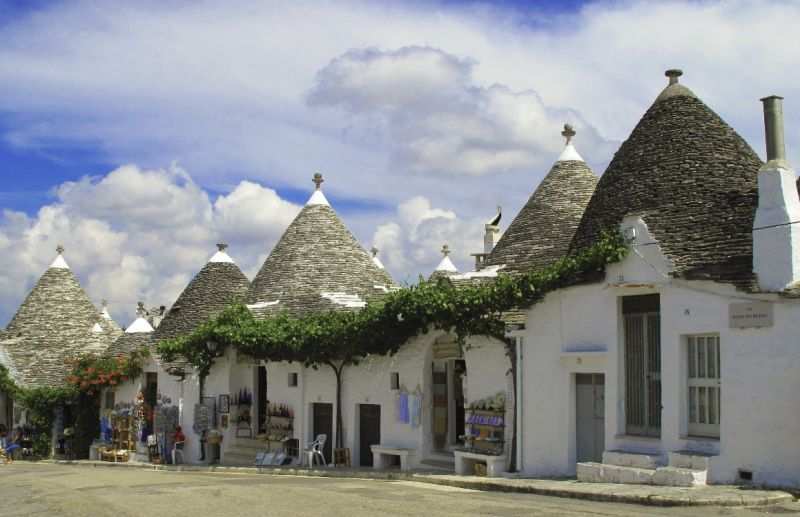 Photo source: albergodiffusoceglie.it.
Photo source: albergodiffusoceglie.it.
Pompeii, Herculaneum and Torre Annunziata (3-5)
These archaeological zones are UNESCO sites in Campania, they are not far from Naples. All of them: Pompeii and Herculaneum and Torre Annunziata were once destroyed by the eruption of the formidable volcano Vesuvius.
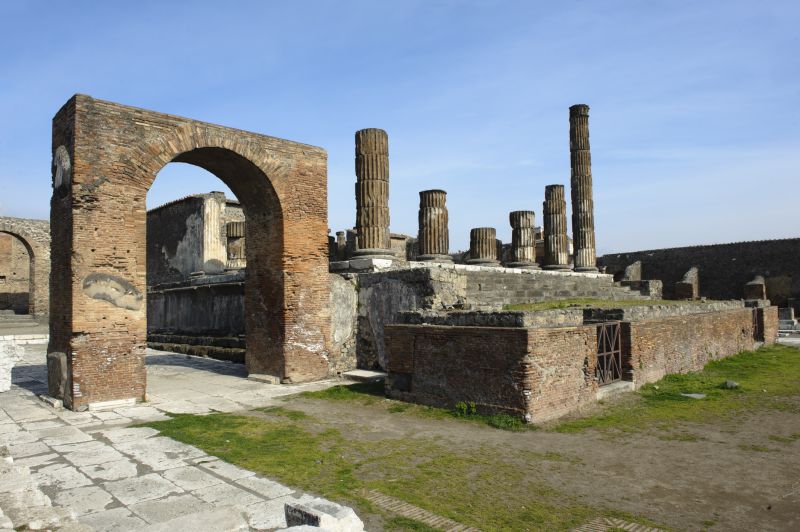 Photo: © federico.fiorillo - Fotolia.com.
Photo: © federico.fiorillo - Fotolia.com.
Information for travellers
- What to see in the province of Naples
- Temples of the province of Naples
- Where to stay in the province of Naples
Archaeological sites and the Patriarchal Basilica, Aquileia (3-4, 6)
The ancient city of Aquileia is located in the province of Udine (Friuli-Venezia Giulia). The UNESCO sites in Aquileia are the Patriarchal Basilica (with a baptistery and mosaic floor of the 4th century) and an extensive archaeological zone.
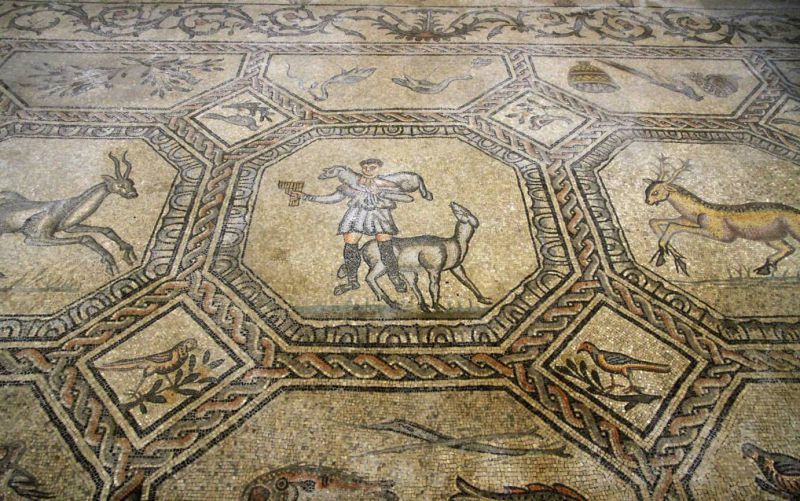 Photo source: touringclub.it.
Photo source: touringclub.it.
Information for travellers
- What to see in Udine
- Temples of Udine. The Cathedral of Santa Maria Maggiore, the Basilica of Beata Verdine delle Grazie, the Church of San Francesco
- Where to stay in Udine
The Church of Santa Maria delle Grazie and The Last Supper, Milan (1, 2)
In 1980, UNESCO sites of Milan – a complex of the Dominican monastery, together with the central church of Santa Maria delle Grazie and the "Last Supper" (15th century ) – were the first in the World Heritage List of Italy. The legendary painting of Leonardo da Vinci is on the wall of the monastery refectory. Here it miraculously survived even during the Second World War.
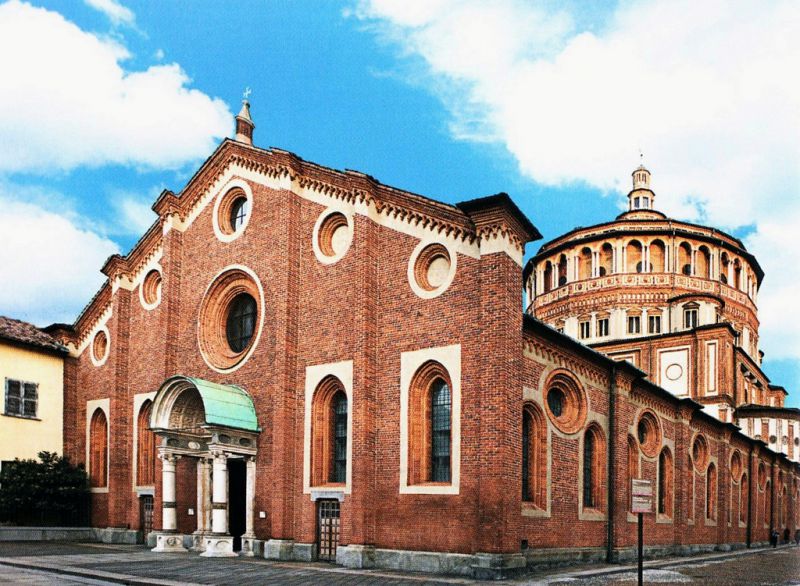 Photo source: dfiles.me.
Photo source: dfiles.me.
Information for travellers
The city of Vicenza and the Palladian villas, Veneto (1-2)
Vicenza is called the city of Andrea Palladio, the great architect of the late Renaissance and Mannerism. He built many villas in the outskirts of Vicenza and Venice. La Rotonde, Villa Almerico-Valmarana are especially famous among the UNESCO sites in Veneto.
 Photo source: thepalladiantraveler.com.
Photo source: thepalladiantraveler.com.
Information for travellers
Botanical Garden, Padua (2-3)
Padua Orto Botanico, also located in the Veneto region, is the oldest permanent botanical garden in the world. This UNESCO site in Padua dates back to the 16th century.
 Photo source: blog.zingarate.com.
Photo source: blog.zingarate.com.
Information for travellers
Mantua and Sabbioneta (2-3)
The cities of Mantua and Sabbioneta in the province of Mantua (Lombardy) represent two different types of planning, characteristic of the Renaissance. Mantua from the beginning is dynamic, while Sabbioneta is the dream of an ideal urban settlement of that time.
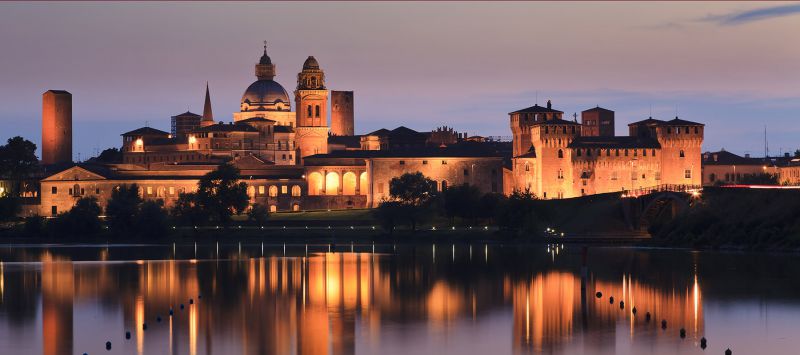 Mantua. Photo source: camperclubmantova.com.
Mantua. Photo source: camperclubmantova.com.
Information for travellers
The historic centre of Naples (2, 4)
UNESCO sites in Naples are constantly in danger: the location on the western slope of Vesuvius, in the most seismic zone, has repeatedly questioned their future. What, however, makes the historic centre of the city even more valuable for us. Among the famous sights of Naples is the church of St Clara and Castel Nuovo.
 Photo source: vindiatours.eu.
Photo source: vindiatours.eu.
Information for travellers
The historic centre of Urbino (2, 4)
The center of this beautiful city (the province of Pesaro e Urbino in Marche) originated in the Renaissance. The most significant of the UNESCO sites in Urbino are the palace of the Urban dukes of Palazzo Ducale and the Cathedral of the Taking of the Blessed Virgin Mary into Heavenly Glory.
 Photo source: discovermarche.wordpress.com.
Photo source: discovermarche.wordpress.com.
Information for travellers
- What to see in Urbino
- Temples of Urbino. Particularly interesting are the two churches of the 15th century: San Domenico and San Spirito
- Where to stay in Urbino
City of Verona, Veneto (2, 4)
Romantic Verona, the city of Romeo and Juliet, belongs to the World Heritage. In the past, the city often suffered from floods, the risk of which has now been reduced to a minimum. It is this that gives hope that the UNESCO sites in Verona will continue to exist for many years to come. If you want to see the legendary old city, go to the areas of Veronetta and San Zeno.
 Photo source: kingofwallpapers.com.
Photo source: kingofwallpapers.com.
Information for travellers
Sacri-Monti, Piedmont and Lombardy (2, 4)
Sacri-Monti Ensembles – The Holy Mountains include nine groups of chapels in the north of Italy. They were erected on the slopes of the mountains in the 16th and 17th centuries. These sacred UNESCO sites in Piedmont are located in Biella, Valperge, Varallo, Giffe, Domodossol, Orta San Giulio and Serralunga di Crea. Besides them, two more chapels – also sites of UNESCO – in Lombardy are in Varese and Ousuccio.
 Photo source: collectionpostcards.wordpress.com.
Photo source: collectionpostcards.wordpress.com.
Information for travellers
Le Strada Nuova and Palazzi dei Rolli, Genoa (2, 4)
Le Strade Nuove (Via Garibaldi) street and the Palazzi dei Rolli Palace complex along the street form the single architectural block of UNESCO facilities in Genoa (Liguria ). The aristocratic palaces of the Palazzi dei Rolli were built in the era of Mannerism, which is already familiar to us.
 Photo source: palazzideirolli.it.
Photo source: palazzideirolli.it.
Information for travellers
- What to see in Genoa
- Temples of Genoa. The most famous are the Cathedral of St Lawrence and the cathedral chapel of San Giovanni
- Where to stay in Genoa
Rhaetian Railway (2, 4)
Unusual railway in the cultural landscape of Albula and Bernina is protected simultaneously by Italy and Switzerland. The nearest town in Italy is Tirano. Thus, this landmark and technical miracle is attributed to the province of Sondrio and is included to UNESCO sites in Lombardy.
 Photo source: italy-cycling-guide.info.
Photo source: italy-cycling-guide.info.
The Arab-Norman heritage of Palermo, Sicily (2, 4)
UNESCO sites in Palermo – the Arab-Norman heritage – are two palaces, three churches, a cathedral and a bridge. The cathedrals in the cities of Monreale and Cefalú are not far away, on the territory of the province of Palermo. These are sights, which, among other things, symbolize the multiculturalism of the island of Sicily in the 11-13 centuries.
 Iconography of the cathedral in Montreal. Photo source: thatsalltrends.com.
Iconography of the cathedral in Montreal. Photo source: thatsalltrends.com.
Information for travellers
- What to see in the province of Palermo
- Temples of the province of Palermo
- Where to stay in the province of Palermo
Cilento and Vallo di Diano, Paestum e Vella, Certosa di Padul in Campania (3-4)
As one complex in the World Heritage, several rare historical and natural attractions entered UNESCO sites list of Campania at once. This is the cultural landscape of the Cilento area, the Vallo di Diano National Park, the archaeological sites of Paestum e Vella, as well as the monastery of Certosa di Padul.
 Paestum. Temple of Athena. Photo source: wtg-global.net.
Paestum. Temple of Athena. Photo source: wtg-global.net.
Information for travellers
Prehistoric pile settlements in the Alps (3-4)
In Italy there are 19 pile dwellings – UNESCO sites in the Alps – are in Friuli-Venezia Giulia, Lombardy, Piedmont and Trentino-Alto Adige. This is a common European heritage of the Neolithic and Bronze Age. Italy preserves unique settlements on marshy banks along with Austria, Germany, Slovenia, France and Switzerland.
 Photo source: atlasofwonders.com.
Photo source: atlasofwonders.com.
The vineyard landscape of Piedmont: Langhe-Roero and Monferrato (3, 5)
The Piedmont region is famous not only for the residences of the house of Savoy, but also for the red wines that come from the wonderful vineyards. UNESCO sites in Piedmont clearly indicate the success of the joint efforts of nature and man: those are five territories of vineyards with unique landscapes and the Grinzane Cavour castle.
 Photo source: touringclub.it.
Photo source: touringclub.it.
Rock Drawings of Val Camonica, Lombardy (3, 6)
Petroglyphs of Val Camonica are rare in their antiquity UNESCO sites in the province of Brescia. Cave painting pushed the Italians to create eight archaeological parks and reserves in different cities of the province, and also pointed to the many periods and epochs of human development (from 6000 BC to 19 century AD). This is the largest European collection of petroglyphs (about 300 thousand copies).
 Photo source: travelchannel.com.
Photo source: travelchannel.com.
Information for travellers
- What to see in Brescia
- Temples of Brescia. Sacred memorials are especially interesting in the city of Brescia, the center of the province. For example, the Old and New Cathedrals (Duomo Vecchio and Duomo Nuovo)
- Where to stay in Brescia
Crespi d'Adda, Lombardy (4-5)
The factory village of Crespi D'Adda is located in the commune of Capriate San Gervasio (province of Bergamo). UNESCO sites in Crespi d'Adda unite the generic neo-Gothic castle of Crespi entrepreneurs, many exemplary quarters of workers and factory buildings, as well as the necropolis of this unusual village.
 Photo source: in-lombardia.it.
Photo source: in-lombardia.it.
Information for travellers
- What to see in the province of Bergamo
- Temples of Bergamo. In the central city of the province, it is worth to visit the Basilica of Santa Maria Maggiore and the Cathedral of Bergamo
- Where to stay in Bergamo
The cultural landscape of Val d'Orcia, Tuscany (4, 6)
Val d'Orcia (14th–15th century) is located near the cities of Siena and Pienza. It is an attempt to create a unique landscape that inspired not one artist of the Siena school. Today, the cultural landscape of Val d'Orcia is one of UNESCO's most interesting sites in Tuscany, as it reflects the harmonious cooperation of man with nature.
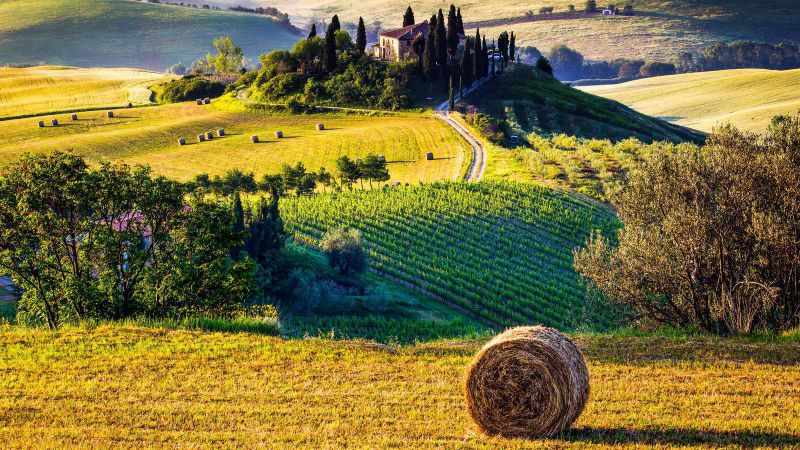 Photo source: old.mytours.clienti.dinamocloud.com.
Photo source: old.mytours.clienti.dinamocloud.com.
The Dolomite Alps (7-8)
The Dolomite Alps occupy a special place among UNESCO sites in Northern Italy (the territory of the regions of Veneto, Trentino Alto Adige, Friuli Venezia Giulia). These amazing mountains are familiar to all professional European skiers and fans of outdoor activities in winter. And in the summer there is a pleasant coolness and simply breathtaking green landscapes of the mountain nature...
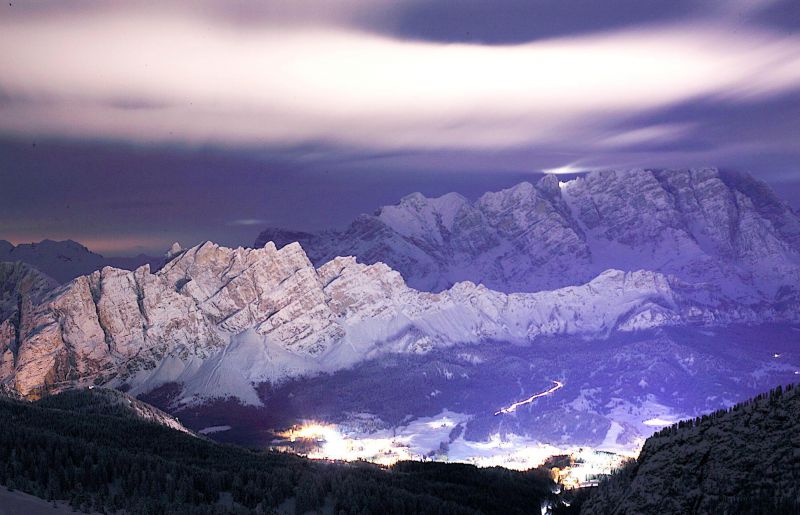 Photo source: 500px.com, by Loris Sponda.
Photo source: 500px.com, by Loris Sponda.
Information for travellers
- What to see in Trentino Alto Adige
- Temples of Trentino Alto Adige
- Where to stay in Trentino Alto Adige
Aeolian Islands, Sicily (8)
The Aeolian Islands belong to the Sicilian province of Messina. The group unites seven islands in the Tyrrhenian Sea. These natural sites of UNESCO heritage are located to the north of the island of Sicily.
 Photo source: blog.tripnpeople.com.
Photo source: blog.tripnpeople.com.
Information for travellers
The Etna volcano, Sicily (8)
Etna belongs to the natural sites of UNESCO on the island of Sicily. The volcano is situated in the province of Catania, next to the province of the same name. This is one of the most significant active volcanoes in Italy.
 Photo source: wired.com.
Photo source: wired.com.
Information for travellers
- What to see in Catania
- Temples of Catania. Cathedral of St Agatha, the collegiate Santa Maria dell’Elemosina, the Basilica of St Nicholas, the church of St Francis and St Benedict, etc.
- Where to stay in Catania
Mount San Giorgio, Lombardy (8)
On the territory of Italy, Mount San Giorgio is located in the province of Varese and belongs to the natural sites of UNESCO in Lombardy. At the same time, the main part of this mountain is geographically located in Switzerland. San Giorgio carefully preserves the fossils of marine life, living 245-230 million years ago.
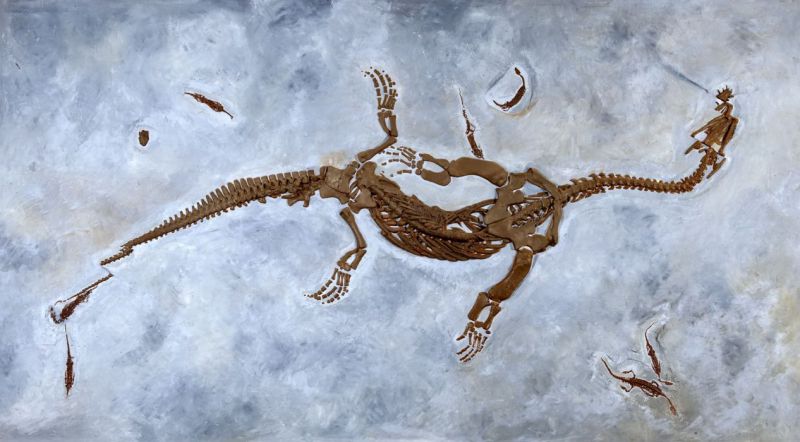 Photo source: ticinotopten.ch.
Photo source: ticinotopten.ch.
Information for travellers
- What to see in Varese? The center of the province, the city of Varese, prides itself on the Basilica of San Vittore and the villa of Francesco d'Este. Near the city there are chapels Sacri Monti.
- Temples of Varese
- Where to stay in Varese
By the way, there is already a new preliminary UNESCO list, which also contains a large number of the future candidates for the World Heritage of Italy. In this list there are more than 40 objects. Many of them can soon confirm their value and complement the UNESCO World Heritage.
There are candidate sites in new categories. They draw our attention to the rare natural attractions of Italy, including examples of the development of ecosystems (9) and biological diversity (10), particularly in need of protection and preservation.












